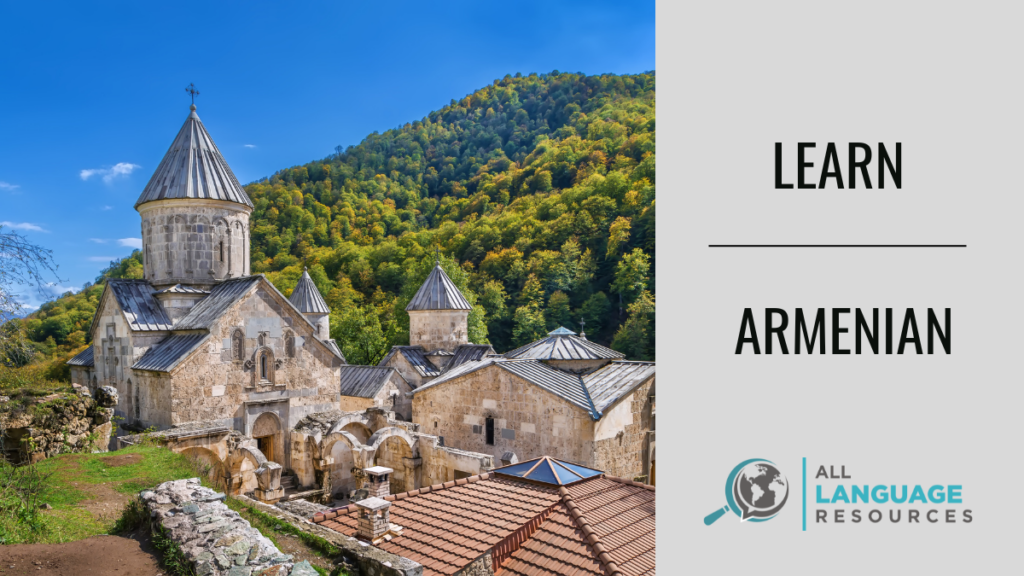Are you reconnecting with Armenian roots? Preparing for a journey back to your long-ago homeland?
Do you want to visit ancient ruins at Garni, see stunning vistas at monastic sites such as Tatev and Geghard, or savor the lights and sights of Yerevan? Or do you simply want to form stronger friendships in the global Armenian community?
No matter what your motivation, learning the Armenian language can be your passport to the richness of Armenian culture, connecting you with speakers in Armenia and across the world.
Discover Armenian with this beginner-friendly guide, exploring grammar, vocabulary, and answers to FAQs. Start your Armenian learning journey now!
A Little Bit About the Armenian Language
The Armenian language has a long, fascinating history, stretching back at least sixteen centuries. It’s part of the Indo-European language family—just like more familiar “cousins” such as French, Spanish, Italian, and German.
However, unlike most Indo-European languages, Armenian stands alone on its own branch of the family tree. Armenian is an offshoot of the Armeno-Aryani limb, which has its roots in the Aryano-Greco-Armenic languages.
While Armenian has been a world language for over a millennium, events within the past hundred years have radically changed the language’s course. The tragic Armenian genocide of the early 20th century resulted in a diaspora that spread the language across the world and widened the divide between the two major standardized forms: Eastern and Western Armenian.
Eastern vs Western Armenian
Eastern and Western Armenian have been diverging from their common, classical root for centuries. As speakers of Western Armenian have settled in many other lands over the past century, the two forms of the language have grown further apart.
How does Western Armenian differ from the Eastern form?
- Pronunciation
- Spelling
- Word choice
- Idiomatic expressions
If you’re a native speaker of one standardized form of Armenian, you should be able to understand the other standardized form without much trouble—just like native speakers of American English and British English can usually understand one another.
But there’s a world of difference between a native speaker and a novice.
For a fledgling Armenian speaker, variations in pronunciation, syntax, and common phrases could be very confusing. When you’re first learning Armenian, you’ll want to focus on either Eastern or Western Armenian.

Eastern Armenian is the official language of the Republic of Armenia. You’ll also find speakers of Eastern Armenian in the Russian Federation, the Republic of Georgia, Iran, and the Republic of Artsakh.
There are about three million native speakers of Eastern Armenian in the Armenian Republic itself, plus many more outside of Armenia, who have produced a wealth of media for the aspiring language learner to enjoy.
The other standardized form of the Armenian language is Western Armenian, which is often identified as the language of the diaspora—the language of the people who left Armenia to settle in countries around the world. Western Armenian only has about a million speakers worldwide. Although some Armenian speakers consider Eastern Armenian truer to classical Armenian than its Western counterpart, others recognize the legitimacy of both forms.
Western Armenian is spread across many different countries, in immigrant communities. Some have formed ethnic Armenian communities in their new countries, such as Little Armenia in Los Angeles—where about 172,000, or roughly half of the local Armenian community, speak Armenian. However, economics and other driving forces often marginalize the Armenian language among expatriates. With a dwindling number of native speakers, Western Armenian has become an endangered language. Still, it’s a tie that binds together families of Armenian heritage throughout the world.
So, the question remains: As a new student of Armenian, which form should you try to learn?
Ultimately, the best way to decide is to look at your own motivations for learning Armenian, and how you plan to use it.
If you want to travel, live, or work in the Republic of Armenia, Eastern Armenian would be a more practical choice. If you’d like to communicate better with Armenian speakers in other parts of the world—such as America, France, Syria, Lebanon, or Turkey—then Western Armenian would be a better bet.
Whatever you decide, you’ll need to start your journey by tackling the Armenian alphabet.
The Armenian Alphabet

Unlike many other Indo-European languages, such as English, Italian, Flemish, and Portuguese, Armenian is not written in the Latin alphabet. Armenian has an alphabet all its own.
The Armenian alphabet was invented by Masrop Mashtots, a theologian and scholar, in 405 AD. Today, both Western and Eastern Armenian use the same alphabet, although there are some pronunciation differences between these two dialects. (In most cases, the Eastern pronunciations follow those of Classical Armenian, which is also known as Grabar.)
While you can find some written materials that have been transliterated—given phonetic representation—in the familiar Latin alphabet, it’s better to get used to the Armenian alphabet right off the bat. Knowing the Armenian alphabet well will help you learn the proper pronunciations, as well as open up a whole world of Armenian writings.
Since mastering the Armenian alphabet is such a crucial part of learning the language well, we’ve found several resources to help. Stay tuned for useful websites, books, and apps to get you off to a running start with the Armenian alphabet…and then on to a long, satisfying marathon of Armenian language learning.
How to Learn Armenian
With its unique alphabet, relatively small number of speakers, and dialectical divide, learning Armenian may present a few more challenges than taking up a more prominent language like Spanish or German.
Like all language learning, learning Armenian requires a long-term commitment. Even if you can only spare a few minutes a day, you’ll want to be consistent so you can reinforce what you’ve learned.
When you’re learning a language, it’s important to lay a good foundation. You’ll need to grasp fundamental concepts like the alphabet and basic pronunciation, as well as common words and phrases.
And don’t forget grammar and syntax. These essentials give the language its shape and structure. Without them, you could memorize thousands of Armenian words, but still not be able to put an intelligible sentence together.
Every spoken language is a living entity—growing and changing to adapt to the needs of its speakers. Learning the language from several different sources can give you a more complete picture of the language as it’s used by native speakers.
We’ll present you with a variety of resources to mix and match, so you can get a good grounding in Armenian without getting burnt out or bored.
What’s the Best Way to Learn Armenian?
For most language learners, the best way to learn Armenian is to use a structured course to make sure you cover all key aspects of the language, but pair it with auxiliary resources like a conversation app or a tutor.
A structured course like Pimsleur will help you understand the shape of the language and how it works compared to English. But for real-life practice, it is a good idea to find a safe environment to converse with your fledgling Armenian, too!
What’s the Easiest Way to Learn Armenian?
The best way to learn Armenian is to immerse yourself in the language. If you don’t have Armenian friends or family you can visit, perhaps you can apply for a study abroad program. If not, you can do the next best thing–create an immersive environment in your own home.
To do this, think about swapping out English for Armenian as much as possible in your daily life. For example, instead of watching an American TV show, find a series of Armenian YouTube videos to watch as you relax on the weekend. Listen to Armenian music, and try reading the news on an Armenian website!
How Long Does it Take to Learn Armenian?
According to the Foreign Service Institute (FSI), it takes the average English speaker 1,100 hours of class time to learn Armenian.
This means that if you use an app like Pimsleur for 30 minutes a day, you could reach an intermediate level of fluency in six and a half years. On the other hand, if you can devote two hours a day to dedicated study time, you could learn Armenian in about a year and a half.
How to Learn Armenian Fast
One of the best ways to learn Armenian fast is to create your own study schedule to help you stay consistent each day. You may want to incorporate multiple study tools. For example, you could use an app-based course for thirty minutes in the morning as you drink your coffee or tea. Then you could listen to an Armenian podcast as you commute to work or school.
Later in the day, you might schedule a conversation using a free app, or book a tutoring session using a tool like italki. Having a set schedule that works Armenian study into the available times of your day will ensure that you build your language skills consistently.
Additional Resources For Learning Armenian
You have your courses and apps that you use as your main resources for learning Armenian, but having supplementary learning resources is never too much. Armenian books, news, and music can be great ways to help you elevate your proficiency level.
Armenian Books
Cement your knowledge of the written language with some Armenian reading material.
Start off easy with children’s literature. Bilingual children’s books can help clue you into the new language, and the simple plots will make your journey to Armenian reading simpler. Here are a couple of choices to get you started.
An original story about a boy with a misplaced wolf, Sleep Tight, Little Wolf by Ulrich Renz has been translated into numerous languages. It’s available as a paperback or an ebook, with access to an MP3 audiobook version.
Svetlana Bagdasaryan’s series, My Grandma’s Tales, includes illustrated fairy tales from around the world, such as Puss in Boots, The Little Mermaid, The Bremen Town Musicians, and Rapunzel.
If you’re looking for Armenian language textbooks, here are a few selections available on Amazon:
- Conversational Armenian Quick and Easy (Eastern Armenian) by Yatir Nitzany
- Learning Armenian Headstart: Manual for foreigners (Eastern Armenian; paperback with CDs) by Lusine K. Muradyan
- Eastern Armenian For English Speakers: Easy Guide to Master the Alphabet, Grammar and Vocabulary by A. Mkhitaryan
- (Mayreni 1): Eastern Armenian Language Textbook for 1st Grade Elementary School by Anzhel Kyurkchyan
- (Mayreni 1): Western Armenian Language Textbook used in the Diaspora for 1st Grade Students by Anzhel Kyurkchyan
- Western Armenian Dictionary & Phrasebook by Nicholas Awde
Once your Armenian knowledge becomes more advanced, enjoy a broader selection of books from these online Armenian bookstores:
Abrilbooks features books in both Western and Eastern Armenian. The site also sells Armenian videos and music, so you can try multimedia learning modalities. (Use the language filter on the left sidebar to choose media in Western or Eastern Armenian.)
California-based Sardarabad sells both Eastern Armenian and Western Armenian books. The selection of Eastern Armenian books is larger than the Western collection and even includes a translation of George Orwell’s classic dystopian novel, 1984.
Want to read Armenian ebooks online? Haybook is similar to Project Gutenberg for Armenian speakers and students. It aggregates free Armenian ebooks, as well as poetry, plays, and short stories. There are also resources such as Armenian dictionaries and children’s literature. The site pulls in electronic reading materials from all different sources, including Google Books.
Other Media Resources For Learning Armenian
Here are some additional resources that will help you in your quest to learn Armenian:
If you’d like to practice typing using the Armenian alphabet, this virtual Armenian keyboard makes it easy. With a simple click, you can email, tweet, search for, or translate your Armenian text.
Keep up with the news and practice your Armenian language skills at the same time. UC Berkeley hosts a large online Armenian studies collection, which includes links to Armenian news sources, such as the Massachusetts-based Armenian Weekly (available in both English and Armenian) and the Yerevan-based Aravot news publication (also available in Russian and English).
Don’t just read and speak Armenian—fill your ears with Armenian music!
A search for Armenian music on Spotify will yield everything from classical to choral, folk to funk.
AM Armenian Music by h_samsonian is a Spotify playlist that boasts a plethora of Armenian pop hits.
Dive into traditional Armenian culture with these tracks on Spotify. This playlist features the double-reeded duduk, a traditional Armenian wind instrument. Many of them have vocals in Armenian to enrich your language studies.
Armenian music site Haykakan Music has Armenian music videos, playlists from contemporary Armenian artists, and links to streaming Armenian radio stations.
The Yerevan Nights Armenian Radio app streams its own Armenian radio broadcasts to your favorite iOS or Android device.
The Armenian Radio Stations app by Ciprian Marin, available for Android users, aggregates numerous Armenian radio stations for streaming. It includes both AM and FM stations, a built-in search feature, a Favorites list, and a sleep timer so you can drift off to the sounds of the Armenian airwaves. It also displays the artist and song name, and integrates sharing to Twitter, Facebook, or email.

Learning Armenian: Opening Up a New World
As you begin your Armenian language learning journey, remember to keep yourself open to new resources.
Learning grammar and syntax is essential for speaking Armenian well. Yet it’s equally important to expose yourself regularly to the living language, as it’s used by native speakers. And don’t let yourself get frustrated. Learning any language is challenging, but it’s ultimately a satisfying pursuit that will enhance many facets of your life.
As the old Armenian proverb says, “Ինչքան լեզու գիտես` այնքան մարդ ես:”
In other words: The more languages we know, the more human we become.
And the more languages we know, the better we can connect with our fellow humans.

